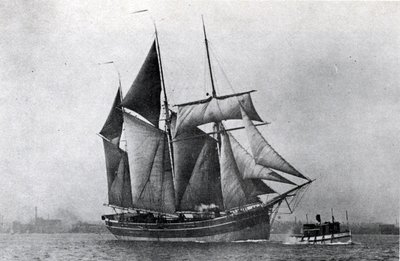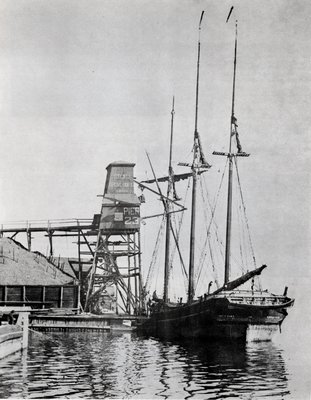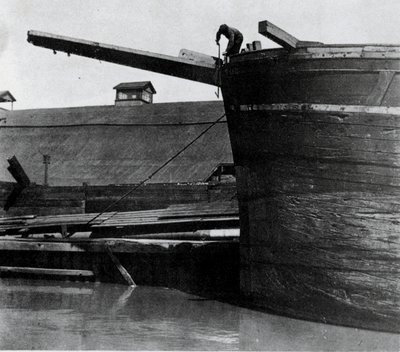Table of Contents
We have been pleased to bring you in these pages, over the last fourteen years, the stories of quite a wide assortment of ships. We have, however, regretted our inability to feature many of the sailing vessels which were once so common on our waters, and which played such an important part in the early development of the lake shipping industry. In fact, on only one previous occasion has a sailing vessel appeared as a Ship of the Month, that being REUBEN DOUD. Her story appeared in Volume VII, Number 7, back in April, 1975.
The simple fact of the matter is that we are not experts on sailing ships, our particular forte being the steamers that superceded them. As a result, we just do not have enough information available to prepare full-length features on lake sailing vessels. There are a few exceptions to this situation, however, and this time around we are pleased to bring you the story of a schooner, later a barge, which was a familiar sight in the Toronto area for many years.
One of the largest and most famous of the once huge fleet of Canadian lake schooners was the W. R. TAYLOR. She was built near Mill Village at South Bay in Ontario's Prince Edward County (near the eastern end of Lake Ontario) in 1877 by George Dickson (or Dixon). It is believed that her first owner was her namesake, Mr. W. R. Taylor, who used her in the timber trade. She was one of the few lake schooners to be constructed with two centreboards. In order to facilitate the loading and unloading of cargo, she was fitted with the usual timber ports in her hull and transom.
Not much is known about the early years of the career of W. R. TAYLOR. After a decade of service, mainly in the timber trade, she went ashore in 1888. Salvaged, she was taken to Port Robinson, on the Welland Canal, and there, in 1889, she was rebuilt and enlarged. Her revised measurements indicated that she had a length of 164.8 feet in length, 26.8 feet in the beam, and 12.7 feet in depth. Her Gross Tonnage was registered as 458. Incidentally, her official number was C.72964.
At the time of her rebuilding, the schooner was owned by Dunn and Company of Quebec City. During the reconstruction at Port Robinson, her name was changed from W. R. TAYLOR to STUART H. DUNN, the new name having been chosen to honour a member of the owning firm. The timing of the rechristening of the schooner would tend to indicate that she had only recently been purchased by Dunn and Company, probably only after she had been refloated following her stranding. Interestingly, her full name appeared only on her stern. On her bows and her nameboards, she carried only the abbreviated version "S. H. DUNN".
STUART H. DUNN was an imposing vessel, for she spread thirteen pieces of canvas when under full sail. She sported four jibs, a square fore topsail, two single raffees, a foresail, mainsail and mizzen, as well as three gaff topsails. She was, of course, a three-master. Her stern bore the famous Masonic emblem, the "Square, Compass and G" insignia which was so commonly displayed on lake vessels during the nineteenth century.
After her reconstruction, and through the 1890s, STUART H. DUNN spent most of her time carrying squared oak timbers, for export, from Toledo, Ohio, to Garden Island, at the foot of Lake Ontario near Kingston. There, the timber was unloaded and formed into rafts which were sent down the St. Lawrence River to Quebec City. Rafting avoided the high cost of shipping timber in vessels down through the old St. Lawrence Canals, for the rafts were sent down straight through the rapids. Much of the timber carried by STUART H. DUNN was supplied by E. L. Kelsey, a Detroit lumber merchant, for the account of Dunn and Company.
Since many of STUART H. DUNN's cargoes were unloaded at Garden Island, and as she was registered at the port of Kingston, many people erroneously assumed that the schooner was a part of the famous Calvin fleet of timber droghers that was based at Garden Island. Actually, Timothy H. Dunn had been a partner in the Quebec City end of the Calvin Company's forwarding business from 1843 to 1850, during which time the Quebec firm was known as Dunn, Calvin and Company Ltd. Later, Stuart H. Dunn became a principal in Dunn and Company, and he was associated with the Calvins in several business ventures.
In the early 1900s, when the trade in squared timber had been exhausted, the STUART H. DUNN was sold to the Conger Coal Company of Toronto, of which Capt. A. J. Foster was manager. For some time, the DUNN was sailed by the veteran shipmaster, Capt. Alex Ure. The schooner was used by Conger Coal for carrying anthracite coal, usually to Toronto from the ports along the south shore of Lake Ontario. She spent many of her winters laid up in the old Church Street slip on the Toronto waterfront, where she was joined by several other old sailing vessels.

A spirited Murphy photo, c. 1908, caught STUART H. DUNN being towed out the Toronto Eastern Gap by the steam tug NELLIE BLY.
By about 1910, however, it had become uneconomical to continue operating STUART H. DUNN as a schooner, and it was decided to cut her down to a barge for use in the coal trade from Lake Ontario to the ports of the St. Lawrence River. Her rigging was cut away and her beautiful spars and bowsprit were sawed off to leave nothing much but her wooden hull, as battered as it was. This transformation was an indignity that was suffered by many a lake schooner in those years, for sail had become a thing of the past in commercial shipping. The hulls of the former schooners, however, could still perform a valuable function, albeit languishing ignominiously at the end of a towline behind a steam freighter or a tug.
By 1913. the STUART H. DUNN's port of registry had been changed from Kingston to Montreal, and Triffle Rondeau of Lanoraie, Quebec, had become her registered owner. The 1914 Dominion register of shipping showed her owner to be Camille Labreque, also of Lanoraie.
By 1918, STUART H. DUNN was owned by Mrs. Thomas Simpson of Montreal. The Simpsons sold the schooner barge about 1920 or 1921 to John E. Russell of Toronto, the famous shipping entrepreneur of whom we have heard much in these pages over the years. Russell used the DUNN for the most part in the Lake Ontario coal trade. During this period, the DUNN spent much of her time on a towline behind Russell's big wooden steam tug JOSEPH L. RUSSELL, which herself had seen better days. Although JOSEPH L. RUSSELL was a most handsome tug indeed, she had been better known in her earlier years as the passenger steamer LAKESIDE, which had operated between Toronto and Port Dalhousie. (LAKESIDE was featured as our Ship of the Month No. 42 in Volume VII, Number 1, in October 1974.) JOSEPH L. RUSSELL also towed the old schooner barge RICKARTON, as well as STUART H. DUNN, and would often bring one of the barges into Toronto with coal, departing with the other which had been unloaded.
STUART H. DUNN was undoubtedly involved in many scrapes over the years, particularly when she was canalling. We are, however, aware of only one serious accident of which she was a victim during her period of operation as a coal barge. On July 4, 1920, whilst upbound from Toronto to a Lake Erie port, presumably to load yet another cargo of coal, she foundered at the Port Dalhousie piers. The DUNN was declared a constructive total loss, but even an accident such as this could not keep the old vessel down. She was raised and repaired, and was soon back in her old service. (We are not aware of circumstances which led to her sinking at Port Dalhousie.)
Nevertheless, by 1924 or 1925, STUART H. DUNN was, not surprisingly, showing the distinctive signs of old age and of the hard usage which she had received in her years of service in the coarse freight trades. No longer suitable for any kind of operation, she was retired and was laid to rest in the boneyard which was situated on the Toronto waterfront, just to the east of the old Jarvis Street dock. Her companions there, all of them decrepit and neglected, were the old Pointe Anne Quarries steam freighter LAKE MICHIGAN, the venerable Russell barge RICKARTON, and the remains of that peculiar creature, Knapp's ROLLER BOAT. Nearby, at the Pointe Anne Quarries wharf, lay the sad remains of the steamer JOHN ROLPH (better known earlier as the "rabbit" RESOLUTE), the schooner barges SOPHIA MINCH and D. P. DOBBINS, the old tug GILBERT, and the stripped-down hull of the steel passenger steamer RITA B. The latter had been brought from Montreal to Toronto by the Toronto Ferry Company Ltd., with the intention of having her rebuilt as a ferry for the Toronto Island service. She was never refurbished and finished out her days as a derelict, and a rather unsightly one at that.
But the mid-1920s were the years when the Toronto Harbour Commission was reconstructing the Toronto waterfront, extending it outward into the Bay and building the docks that have become so familiar in the intervening years (but which, even now, are undergoing yet another series of changes with the development of Harbourfront Park and other projects). Those improvements required the cleaning out of many of the old wharves and buildings, together with the many elderly hulls which had been laid away and long forgotten there. Accordingly, about 1926, the disintegrating hull of STUART H. DUNN was pumped out and towed away from the harbour. She was taken to a marshy inlet near the town of Whitby (just east of Toronto, on the north shore of Lake Ontario), and there she was laid away to rot, much to the chagrin of local residents who were not ecstatic over the prospect of their area being turned into a marine boneyard. In addition to the DUNN, other old wooden hulls were undoubtedly laid away in the same area.
However, her move to Whitby was not the final chapter in the DUNN's history. It is our belief that the rotting remains of STUART H. DUNN were eventually removed from the Whitby boneyard. She was not refloated for any useful purpose, however, but only to be towed out to a deep spot in Lake Ontario, where she was scuttled. Despite the final demise of the old hull, STUART H. DUNN continued to be listed in the Canadian register of shipping for many years as, apparently, her final documents had not been surrendered.
And so ended the career of yet another early lake vessel. This schooner had been built long after steamboats had come to the lakes, and she might have been considered an anachronism even at the time of her construction, when sailing vessels were only being used in specialty trades or by smalltime operators. Nevertheless, she served her various owners well, even if many of her years were devoted to trades that, although necessary, were not of the most romantic nature.
(Ed Note: If any of our members would like to see more sailing vessels featured in these pages, and if they would care to try their hand at preparing such an article for us, or even supplying the information on a particular boat so that we could put together a "Ship of the Month", we would appreciate hearing from them.)
Previous Next
Return to Home Port or Toronto Marine Historical Society's Scanner
Reproduced for the Web with the permission of the Toronto Marine Historical Society.

